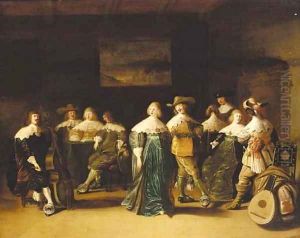Anthonie Palamedes, Called Stevers Paintings
Anthonie Palamedes, also known as Anthonie Palamedesz. and called Stevers, was a prominent Dutch painter born in Delft in 1601. His works are an embodiment of the Golden Age of Dutch painting, a period that witnessed an extraordinary flourishing of the arts in the Netherlands, particularly during the 17th century. Anthonie was part of a family deeply embedded in the artistic milieu of the time; his brother Palamedes Palamedesz. was also a well-regarded artist. Their father, Palamedes Stevens, was a Flemish artist who had moved to the Netherlands, indicating that the artistic talent ran deeply through the family's veins.
Anthonie Palamedes specialized in genre scenes, portraits, and military subjects, displaying a remarkable ability to capture the essence of his era through his canvases. His genre scenes, often vivid and bustling with life, provide a window into the social gatherings of the Dutch elite, including elegant soirees and musical parties. These works are celebrated for their meticulous detail, balanced compositions, and the subtle play of light and shadow, showcasing Palamedes' mastery over the medium.
Despite the apparent influence of his contemporaries, such as Dirck Hals and Frans Hals, Palamedes developed a distinctive style that distinguished his work. His paintings are characterized by a keen observation of social interactions, a vibrant palette, and a dynamic portrayal of figures in motion. This ability to depict the liveliness of his subjects with such fidelity made his works highly sought after during his lifetime.
Palamedes' military scenes are equally notable, often depicting soldiers at rest or in the midst of preparation, reflecting the ongoing conflicts of the Eighty Years' War and its aftermath. These works not only serve as historical documents but also highlight his skill in portraying the human figure and the complexities of martial attire and accoutrements with accuracy and detail.
Throughout his career, Anthonie Palamedes achieved considerable success and recognition. He was an active member of the Guild of Saint Luke in Delft, where he held various positions, including headman, reflecting his status and respect within the artistic community. His influence extended beyond his immediate surroundings, with his works being collected by patrons across Europe.
Anthonie Palamedes passed away in Amsterdam in 1673. Today, his paintings can be found in numerous prestigious collections and museums around the world, testifying to his enduring legacy and the timeless appeal of his art. Palamedes remains a significant figure in the history of Dutch painting, celebrated for his contributions to the genre and portrait painting of the Golden Age.
